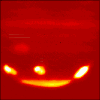 Comet
Hyakutake
Comet
HyakutakeThis is an image of Comet Hyakutake taken with the camera COSMIC on the 200" telescope using a red filter. The exposure time is 1 second. The picture was taken on March 18, 1996, at 10:16 UT. There is a reflection in the image, so north is up and west is to the left.
Another, more satisfying image of Comet Hyakutake, which was taken by Todd Hunter using a 35mm camera, is available here. The reason the image taken with the 35mm camera is so much more satisfying than the image taken with the mighty 200" telescope is that the interesting feature of the comet (i.e. the tail) is just so large that you need a very wide field of view in order to see it. The 200" image only shows a very small field of view centered on the nucleus. (Additionally, the 35mm photo was taken later when the tail was brighter.)
 SL9 in the
infrared
SL9 in the
infraredThese images of Jupiter show several impact sites from Comet Shoemaker-Levy 9. A team of astronomers from Caltech and Cornell University took the pictures using two infrared cameras on the Palomar Observatory 200-inch Hale telescope on July 19th, 1994. Jupiter's South pole is at the bottom of each image, and the planet rotates from left to right.
The image on the left, made at 7:50 pm PDT, is at a wavelength of 10.3 microns, and shows the bottom third of Jupiter including three recent impact sites. At this wavelength we see the thermal radiation from the gases heated by the impacts. Most prominent is site L, setting on the right limb of the planet, which was only about 5 hours old (1/2 Jupiter rotation) at the time the image was taken. Sites G and H also remain visible despite their being about 40 and 30 hours old, respectively. Each of these two smaller spots is about the size of the Earth.
The image on the right shows Jupiter at a wavelength of 2.3 microns about 1 hour later. Since the first image, the planet has rotated about 36 degrees, site L has disappeared off the right limb, and sites E and F have appeared on the left. Most of Jupiter is faint at this wavelength because methane in its upper atmosphere absorbs the incident sunlight before it reaches the main cloud deck. We believe that the impact sites, on the other hand, are bright due to the scattering of light from residues of the cometary impacts deposited at high altitudes. Also visible in this image is the famous Great Red Spot, a bright band north of the equator, and the South Polar Hood, all of which are normally visible on Jupiter.
The observers were:
 SL9 Impact R
movie
SL9 Impact R
movieThese images were taken with the Palomar 60 inch telelscope, using a 1024x1024 CCD to image Jupiter in a methane band (50 Angstroms wide centered on 8900 Angstroms). The 129K MPEG animation has 20 frames showing a comet-bruised rotating Jupiter. On the East (left) limb of Jupiter you can see the spot from impact R rotating into view. This is a negative image, i.e. black is brighter than white. The spots from the comet impacts are seen as bright patches on the southern (lower) hemisphere of the planet. Images were taken by D.Shupe, R.Knop, & T. Murphy with a filter supplied by Dr. J. Westphal. (Note that even though this is supposed to be an Infrared page, this is an animation of optical images. Oh Well.)
For those few who use Amiga Mosaic, here is the same animation as an Op-5 IFF ANIM, though I (Rob Knop) have yet to get this working with my own Amiga.... Something to do with the x-anim mailcap entry. Dunno. If anybody has any hints, please mail me at rknop@mop.caltech.edu.